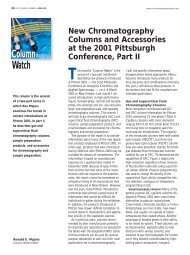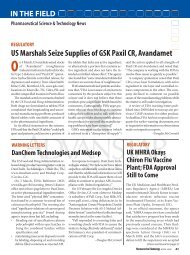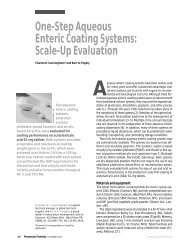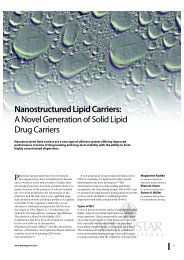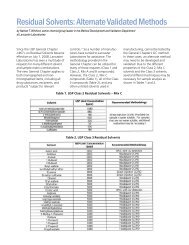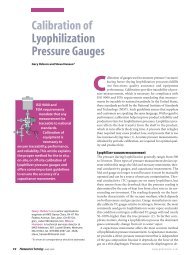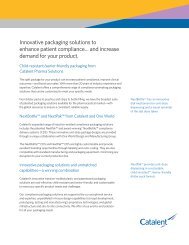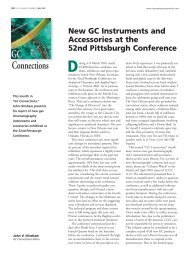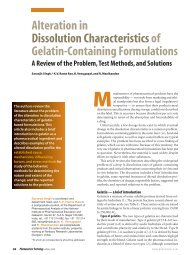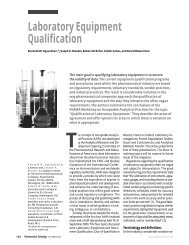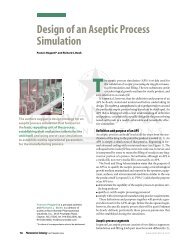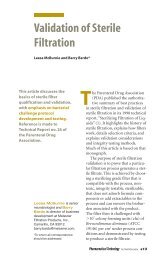Scale Up of Liquid and Semisolid Manufacturing Processes
Scale Up of Liquid and Semisolid Manufacturing Processes
Scale Up of Liquid and Semisolid Manufacturing Processes
Create successful ePaper yourself
Turn your PDF publications into a flip-book with our unique Google optimized e-Paper software.
LIQUIDS AND SEMISOLIDS<br />
<strong>Scale</strong> <strong>Up</strong> <strong>of</strong> <strong>Liquid</strong> <strong>and</strong><br />
<strong>Semisolid</strong> <strong>Manufacturing</strong><br />
<strong>Processes</strong><br />
Lawrence H. Block<br />
The author points out some<br />
major obstacles to effective<br />
scale-up <strong>and</strong> describes<br />
methods available to<br />
pharmaceutical scientists<br />
for addressing scalability<br />
issues.<br />
COMSTOCK<br />
Lawrence H. Block,<br />
PhD, is a pr<strong>of</strong>essor <strong>of</strong><br />
pharmaceutics at the School<br />
<strong>of</strong> Pharmacy, Duquesne<br />
University, Pittsburgh, PA<br />
15282, tel. 412.396.6362,<br />
fax 412.396.5599, block@<br />
duq.edu.<br />
Process scale-up is an increase in<br />
batch size or production capacity,<br />
usually in response to increased<br />
product dem<strong>and</strong>, concerns<br />
about high production costs, or an<br />
increased need for clinical research<br />
supplies. Conversely, scale-down is a<br />
decrease in batch size or productivity,<br />
usually in response to decreased<br />
product dem<strong>and</strong>. Pharmaceutical<br />
manufacturing scales range from<br />
the laboratory to the pilot plant to<br />
full production. The transition from<br />
one scale to another, however, is<br />
fraught with problems.<br />
These problems include but are<br />
not limited to dissimilar processing<br />
equipment between one scale <strong>and</strong><br />
another; various requirements for<br />
process control at different production<br />
scales; insufficient data about<br />
equipment performance at different<br />
production scales; the complexity <strong>of</strong><br />
pharmaceutical processing, which<br />
may involve several very different<br />
unit operations <strong>and</strong> equipment; <strong>and</strong><br />
variations in macroscopic <strong>and</strong> microscopic<br />
properties <strong>of</strong> formulation<br />
components <strong>and</strong> products at different<br />
production scales. Additional<br />
s26 Pharmaceutical Technology SCALING UP MANUFACTURING 2005<br />
www.pharmtech.com
LIQUIDS AND SEMISOLIDS<br />
complications arise from a reliance<br />
on trial-<strong>and</strong>-error methodology to<br />
resolve scale-up problems. Commentary<br />
about the paucity <strong>of</strong> published<br />
data relating to the scalability<br />
<strong>of</strong> pharmaceutical manufacturing<br />
processes is presented elsewhere (1).<br />
This lack <strong>of</strong> information continues<br />
to be a problem <strong>and</strong> fosters a reliance<br />
on empiricism. Yet, changes in<br />
processing equipment, analytical instrumentation,<br />
process analytical<br />
technology, <strong>and</strong> computer s<strong>of</strong>tware<br />
have contributed to a research environment<br />
that facilitates scalability,<br />
particularly in the past 10 years. On<br />
the other h<strong>and</strong>, in an industry in<br />
which competitive advantages may<br />
be gained by an easier approach to<br />
scale-up, publishing one’s achievements<br />
in scalability would not necessarily<br />
be in a manufacturer’s best<br />
interests.<br />
Process variations resulting<br />
from a change in scale<br />
<strong>Scale</strong>-up success <strong>of</strong>ten is thought to<br />
be more likely if geometrically similar<br />
processing equipment is used at<br />
each manufacturing scale. Geometric<br />
similarity means that equipment<br />
shape <strong>and</strong> dimensions are proportional<br />
from one production scale to<br />
another. It would seem, then, that<br />
geometric similarity would ensure<br />
results that are independent <strong>of</strong> scale.<br />
Equipment manufacturers <strong>of</strong>ten tout<br />
the scalability <strong>of</strong> their equipment,<br />
specifically referring to the geometric<br />
similarity <strong>of</strong> various equipment<br />
sizes.<br />
Unfortunately, this claim is not<br />
necessarily true. Although a system’s<br />
A/V, m –1<br />
1000<br />
100<br />
10<br />
1<br />
0.1<br />
A/V <strong>and</strong> V/A as a function <strong>of</strong> <strong>Scale</strong><br />
A/V, m –1<br />
V/A, m<br />
0.01<br />
0<br />
1 10 100 1000<br />
<strong>Scale</strong><br />
Figure 1: The ratio <strong>of</strong> area to volume<br />
(A:V) <strong>and</strong> volume to area (V:A) as a<br />
function <strong>of</strong> scale.<br />
chemical kinetics <strong>and</strong> thermodynamic<br />
properties are not affected<br />
by changes in scale, many other system<br />
properties are affected. Geometric<br />
similarity does not ensure mechanical,<br />
thermal, or chemical<br />
similarity in scaled systems. Pharmaceutical<br />
processes can vary with<br />
scale—even when the equipment<br />
uses the same operating principle<br />
(e.g., a low-shear mixer) <strong>and</strong> the<br />
same design characteristic (e.g., a<br />
planetary mixer) <strong>and</strong> maintains geometric<br />
similarity—thus resulting in<br />
different outcomes for what appears<br />
to be the same process.<br />
<strong>Processes</strong> may be characterized as<br />
dependent on volume, area, or<br />
length. For a given linear change in<br />
scale (L), the effect on area (L 2 ) or<br />
volume (L 3 ) is very different. Thus, a<br />
10-fold change in linear scale results<br />
in a change in volume <strong>of</strong> three orders<br />
<strong>of</strong> magnitude <strong>and</strong> a change in<br />
area <strong>of</strong> two orders <strong>of</strong> magnitude.<br />
Figure 1 shows the dependence <strong>of</strong><br />
the area:volume (A:V) ratio <strong>and</strong> <strong>of</strong><br />
5<br />
4<br />
3<br />
2<br />
1<br />
V/A, m<br />
s28 Pharmaceutical Technology SCALING UP MANUFACTURING 2005<br />
www.pharmtech.com
the V:A ratio on the linear scale. At<br />
small production scales, area is more<br />
prominent than volume. At larger<br />
production scales, volume is far more<br />
prominent than area. As a result,<br />
process outcomes are <strong>of</strong>ten dependent<br />
on scale. Interfacially controlled<br />
processes such as heat transfer, particle<br />
dispersion, or surfactant adsorption<br />
at interfaces during emulsification<br />
are area-dependent processes.<br />
As scale increases, the area relative to<br />
the volume decreases <strong>and</strong> the overall<br />
efficiency <strong>of</strong> the process can decline<br />
considerably.<br />
Volume-dependent processes<br />
such as droplet coalescence in an<br />
emulsion system or the amount <strong>of</strong><br />
heat generated in a system tend to<br />
dominate system behavior at larger<br />
scales. Heat-exchange provisions<br />
(e.g., jacketed equipment) that are<br />
adequate at a small scale may be<br />
grossly inadequate at a larger scale<br />
<strong>and</strong> necessitate a major change in<br />
equipment design. Thus, a problematic<br />
aspect <strong>of</strong> scaling up or down is<br />
the potential for a change in the predominant<br />
mechanism <strong>of</strong> a unit operation<br />
(e.g., mixing or dissolution)<br />
with a change in scale.<br />
When pharmaceutical manufacturing<br />
operations are based almost exclusively<br />
on geometric similarity, attempts<br />
to scale up or scale down the<br />
process <strong>of</strong>ten fail because <strong>of</strong> the effect<br />
<strong>of</strong> changes in scale on the controlling<br />
mechanism(s) in a pharmaceutical<br />
process. As Tatterson points out, “It is<br />
unwise to scale a process without<br />
knowing the controlling mechanisms.<br />
It is required that the controlling<br />
mechanism[s] be the same between<br />
the two different scales. If there is a<br />
mechanism change, then a regime<br />
change has occurred” (2).<br />
The importance <strong>of</strong> mixing in pharmaceutical<br />
manufacturing. Mixing may<br />
be the primary unit operation in a<br />
given process; it is involved in the<br />
manufacture <strong>of</strong> virtually all liquid<br />
<strong>and</strong> semisolid pharmaceuticals. Paul<br />
et al. estimate that mixing problems<br />
related to pharmaceutical process<br />
scale-up <strong>and</strong> process development<br />
cost the pharmaceutical industry<br />
more than $500 million per year (3).<br />
Given the centrality <strong>of</strong> mixing to<br />
the processing <strong>of</strong> pharmaceutical<br />
liquids <strong>and</strong> semisolids, the nature<br />
<strong>and</strong> design <strong>of</strong> the mixing equipment<br />
are <strong>of</strong> the utmost importance to the<br />
manufacturing operation <strong>and</strong> product<br />
replicability from batch to batch.<br />
Flow regimes (hydraulic conditions)<br />
in a pharmaceutical system undergoing<br />
mixing—whether driven by<br />
dynamic or static mixers—can range<br />
from laminar to turbulent in various<br />
regions <strong>of</strong> the system at the same<br />
time.<br />
A transitional-flow regime, in<br />
which flow is neither laminar nor<br />
turbulent but is somewhere in between,<br />
may also be present. The flow<br />
regime in the vicinity <strong>of</strong> an impeller<br />
is <strong>of</strong>ten turbulent, while the flow<br />
regime elsewhere in the system can<br />
be laminar or transitional. A further<br />
indication <strong>of</strong> the importance <strong>of</strong> the<br />
flow regime is evident from the<br />
input power needed per unit volume<br />
for the scale-up <strong>of</strong> geometrically<br />
similar impeller-agitated tank systems:<br />
for a turbulent-flow regime,<br />
power is N 3 D 2 (in which is den-<br />
Pharmaceutical Technology SCALING UP MANUFACTURING 2005 s29
LIQUIDS AND SEMISOLIDS<br />
sity, <strong>and</strong> N <strong>and</strong> D are the rotational<br />
speed <strong>of</strong> the impeller <strong>and</strong> the diameter<br />
<strong>of</strong> the impeller, respectively); for<br />
a laminar flow regime, power is N 2<br />
(in which is the viscosity) (4).<br />
<strong>Scale</strong> up <strong>of</strong> solutions. Ins<strong>of</strong>ar as the<br />
scale-up <strong>of</strong> solutions is concerned,<br />
Gorsky advocates three methods:<br />
application <strong>of</strong> a power law, use <strong>of</strong> dimensionless<br />
numbers, <strong>and</strong> the scale<strong>of</strong>-agitation<br />
approach (5).<br />
The power law approach uses the<br />
following relationship (5):<br />
N 2 N 1 ( 1 R) n [1]<br />
in which n is the power law exponent<br />
<strong>and</strong> N 1 <strong>and</strong> N 2 are the rotational<br />
speeds <strong>of</strong> the impeller at<br />
scales 1 <strong>and</strong> 2, respectively. R is a<br />
geometric scaling factor such as<br />
D 1 T 1 or D 2 T 2 , in which D is the impeller<br />
diameter <strong>and</strong> T is the mixing<br />
tank diameter, or Z 1 T 1 or Z 2 T 2 , in<br />
which Z is the height <strong>of</strong> liquid in the<br />
mixing tank. Depending on the scaling<br />
objective, commonly encountered<br />
values encompass the range 0<br />
n 1. For example, for equal<br />
blend times, n 0; for equal mass<br />
transfer rates, n 2 ⁄3; <strong>and</strong> for equal<br />
solids suspension, n 3 ⁄4.<br />
The dimensionless numbers<br />
method such as the Reynolds number<br />
(i.e., the ratio <strong>of</strong> inertial to viscous<br />
forces in a flow),<br />
R e (D 2 N )<br />
or the Froude number (i.e.,the ratio<br />
<strong>of</strong> inertial stress to the gravitational<br />
force per unit area in a liquid),<br />
F r (DN 2 g)<br />
are used as a means <strong>of</strong> correlating<br />
process characteristics at various<br />
production scales. D, N, <strong>and</strong> in<br />
these dimensionless numbers are the<br />
same as previously defined, whereas<br />
<strong>and</strong> g are density <strong>and</strong> gravitational<br />
acceleration, respectively.<br />
The scale-<strong>of</strong>-agitation approach—<br />
developed in the mid- to late-1970s<br />
(6, 7)—uses the power law relationship<br />
[1] in conjunction with dimensionless<br />
numbers <strong>and</strong> an empirical<br />
scale-<strong>of</strong>-agitation (i.e., bulk-fluid velocity)<br />
to facilitate scale-up under<br />
conditions <strong>of</strong> geometric similarity.<br />
Gorsky provides a detailed review<br />
<strong>and</strong> application <strong>of</strong> the scale-<strong>of</strong>-agitation<br />
approach (5).<br />
These methods tend to be problematic<br />
once the systems deviate<br />
from Newtonian flow behavior <strong>and</strong><br />
geometric similarity. Nonetheless,<br />
Zlokarnik provides a rational basis<br />
for the scaling <strong>of</strong> such systems by<br />
using a rheologically appropriate dimensionless<br />
term to compensate for<br />
the non-Newtonian behavior <strong>of</strong><br />
more-complex systems (8). The rheological<br />
behavior <strong>of</strong> shear-thinning<br />
(pseudoplastic) systems may be described<br />
by the Ostwald–de Waele<br />
equation between the shear rate extremes<br />
corresponding to the zero<br />
shear viscosity, 0 , <strong>and</strong> to the infinite<br />
shear viscosity, :<br />
[2]<br />
in which is the shear stress, is<br />
the rate <strong>of</strong> shear, <strong>and</strong> K <strong>and</strong> a are<br />
constants. The ratio : 0 corresponding<br />
to the ratio : 0 would then be<br />
used to facilitate scaling.<br />
Particularly difficult scale-up problems<br />
arise with the scaling <strong>of</strong> disperse<br />
s30 Pharmaceutical Technology SCALING UP MANUFACTURING 2005<br />
www.pharmtech.com
LIQUIDS AND SEMISOLIDS<br />
systems because multiple, mechanistically<br />
different phenomena are involved<br />
(e.g., coalescence, dispersion,<br />
<strong>and</strong> maintenance <strong>of</strong> particle suspension).<br />
Leng <strong>and</strong> Calabrese note the<br />
difficulties inherent in scaling up an<br />
emulsion system in which differences<br />
in scale result in various proportions<br />
<strong>of</strong> the system behaving in<br />
both a turbulent <strong>and</strong> a laminar<br />
manner (9). Droplet dispersion is<br />
more apt to occur in a turbulentflow<br />
regime such as in a small vessel,<br />
but droplet coalescence is more apt<br />
to occur in a laminar-flow regime<br />
(e.g., in a large vessel). Not surprisingly,<br />
identical outcomes at two different<br />
manufacturing scales are not<br />
readily achieved.<br />
Improving the likelihood<br />
<strong>of</strong> scalability<br />
As Louis Pasteur is reputed to have<br />
said, “Chance favors only the mind<br />
that is prepared.” The pharmaceutical<br />
technologist confronted with a scaling<br />
problem could prepare his or her<br />
mind to increase the likelihood <strong>of</strong><br />
successful scaling <strong>of</strong> formulation<br />
components <strong>and</strong> the product by:<br />
• identifying the physical <strong>and</strong><br />
chemical phenomena involved in<br />
the pharmaceutical manufacturing<br />
process;<br />
• underst<strong>and</strong>ing whether <strong>and</strong> how<br />
these phenomena are affected by<br />
a change in scale (i.e., Are they<br />
dependent on volume, area, or<br />
length?);<br />
• identifying the predominant or<br />
controlling process mechanism;<br />
• identifying the critical process<br />
variables that affect scalability;<br />
• identifying or determining the<br />
physicochemical properties (e.g.,<br />
density, particle size, viscosity) <strong>of</strong><br />
the formulation components <strong>and</strong><br />
the products relevant to scalability;<br />
• using dimensional analysis to reduce<br />
the number <strong>of</strong> variables required<br />
to characterize a process as<br />
the manufacturing scale changes;<br />
• using s<strong>of</strong>tware that enables the estimation<br />
<strong>of</strong> equipment performance<br />
<strong>and</strong> material characteristics.<br />
Dimensional analysis is a powerful<br />
approach to scale-up that deserves serious<br />
consideration as a principal<br />
method <strong>of</strong> affecting equivalent results<br />
at various production scales (10, 11).<br />
Dimensional analysis goes beyond the<br />
mere computation <strong>of</strong> dimensionless<br />
numbers by requiring the analysis <strong>of</strong><br />
a physical process <strong>and</strong> the conditions<br />
under which the process behaves similarly<br />
from one scale to another. This<br />
analysis is necessary if the relevant<br />
physical variables are to be described<br />
in terms <strong>of</strong> the basic dimensions <strong>of</strong><br />
mass, length, time, <strong>and</strong> temperature.<br />
Aside from preparing one’s mind<br />
to tackle a scale-up problem, experimental<br />
<strong>and</strong> computational methods<br />
can have a substantial effect on the<br />
resolution <strong>of</strong> a scaling problem. Experimental<br />
methods range from<br />
laboratory-scale to pilot-plant to fullscale<br />
production studies. Again, geometrically<br />
similar, proportionately<br />
scaled equipment can facilitate data<br />
analysis. Economies <strong>of</strong> scale are lost,<br />
<strong>of</strong> course, in a full-scale production<br />
facility. Such studies are <strong>of</strong>ten prohibitively<br />
expensive.<br />
On the other h<strong>and</strong>, there may be<br />
an advantage to conducting pilot-<br />
s32 Pharmaceutical Technology SCALING UP MANUFACTURING 2005<br />
www.pharmtech.com
plant or full-scale studies using model<br />
systems (i.e., “mock up” studies) that<br />
behave similarly to the pharmaceutical<br />
system that will be scaled. Mockup<br />
studies can provide valuable insight<br />
into size- or scale-related system<br />
behavior without the investigator incurring<br />
the expenses associated with<br />
the actual formulation. Zlokarnik has<br />
used aqueous solutions <strong>of</strong> various hydrocolloids<br />
to simulate conditions in<br />
biotechnology studies (8).<br />
Today, the Internet abounds with<br />
numerous Web sites devoted to<br />
manufacturing process simulations,<br />
particularly those based on mixing<br />
(12, 13). Current literature has<br />
begun to reflect the increasing availability<br />
<strong>of</strong> simulation s<strong>of</strong>tware <strong>of</strong> various<br />
types <strong>and</strong> <strong>of</strong> the increasing importance<br />
<strong>of</strong> pharmaceutical<br />
engineering (14, 15).<br />
It should no longer be necessary<br />
for a pharmaceutical scientist to resort<br />
to empiricism to resolve a scaleup<br />
problem. The likelihood <strong>of</strong> scaleup<br />
success is greater than ever before<br />
because <strong>of</strong> the continued development<br />
<strong>and</strong> refinement <strong>of</strong> s<strong>of</strong>tware for<br />
simulating <strong>and</strong> computing fluid dynamics<br />
in the processing <strong>of</strong> solutions<br />
<strong>and</strong> disperse systems over a wide<br />
range <strong>of</strong> rheological conditions.<br />
Today, scale-up should be considered<br />
a challenge, not a problem.<br />
References<br />
1. L.H. Block,“Nonparenteral <strong>Liquid</strong>s <strong>and</strong><br />
<strong>Semisolid</strong>s,” in Pharmaceutical Process<br />
<strong>Scale</strong>-<strong>Up</strong>, M. Levin, Ed. (Marcel Dekker,<br />
New York, NY, 1st ed., 2002), pp. 57–58,<br />
89–90.<br />
2. G.B. Tatterson, <strong>Scale</strong>up <strong>and</strong> Design <strong>of</strong> Industrial<br />
Mixing <strong>Processes</strong> (McGraw Hill,<br />
New York, NY, 1994), p. 242.<br />
3. E.L. Paul, V.A. Atiemo-Obeng, <strong>and</strong> S.M.<br />
Kresta, Eds., H<strong>and</strong>book <strong>of</strong> Industrial Mixing:<br />
Science <strong>and</strong> Practice (John Wiley &<br />
Sons, Hoboken, NJ, 2004), p. XXXV.<br />
4. G.B. Tatterson, <strong>Scale</strong>up <strong>and</strong> Design <strong>of</strong> Industrial<br />
Mixing <strong>Processes</strong> (McGraw Hill,<br />
New York, NY, 1994), p. 244.<br />
5. I. Gorsky, “Parenteral Drug <strong>Scale</strong>-<strong>Up</strong>,”<br />
in Pharmaceutical Process <strong>Scale</strong>-<strong>Up</strong>,M.<br />
Levin, Ed. (Marcel Dekker, New York,<br />
NY, 1st ed., 2002), pp. 43–56.<br />
6. R.W. Hicks <strong>and</strong> L.E. Gates,“Turbine Agitator<br />
Selection,” Paint Varnish Production<br />
64 (5), 43–47 (1974).<br />
7. R.W. Hicks et al., “How to Design Agitators<br />
for Desired Process Response,”<br />
Chem. Eng. 26 April 1976, 102–110.<br />
8. M. Zlokarnik, “<strong>Scale</strong>-<strong>Up</strong> <strong>of</strong> <strong>Processes</strong><br />
Using Material Systems with Variable<br />
Physical Properties,” Chem. Biochem.<br />
Enq. Q. 15 (2), 43–47 (2001).<br />
9. D.E. Leng <strong>and</strong> R.V. Calabrese, “Immiscible<br />
<strong>Liquid</strong>–<strong>Liquid</strong> Systems,” in H<strong>and</strong>book<br />
<strong>of</strong> Industrial Mixing: Science <strong>and</strong><br />
Practice, E.L. Paul, V.A. Atiemo-Obeng,<br />
<strong>and</strong> S.M. Kresta, Eds. (John Wiley &<br />
Sons, Hoboken, NJ, 2004), pp. 639–753.<br />
10. M. Zlokarnik, Dimensional Analysis <strong>and</strong><br />
<strong>Scale</strong>-up in Chemical Engineering<br />
(Springer-Verlag, Berlin, Germany, 1991).<br />
11. M. Zlokarnik, “Dimensional Analysis<br />
<strong>and</strong> <strong>Scale</strong>-<strong>Up</strong> in Theory <strong>and</strong> Industrial<br />
Application,” in Pharmaceutical Process<br />
<strong>Scale</strong>-<strong>Up</strong>, M. Levin, Ed. (Marcel Dekker,<br />
New York, 1st ed., 2002), pp. 1–41.<br />
12. CFD Review, accessed 13 February 2005,<br />
http://www.cfdreview.com.<br />
13. VisiMix 2000: Mixing Simulation for<br />
Chemical & Process Engineers, accessed<br />
22 February 2005, http://www.on-line.<br />
visimix.com.<br />
14. H.S. Pordal, C.J. Matice, <strong>and</strong> T.J. Fry,<br />
“The Role <strong>of</strong> Computational Fluid Dynamics<br />
in the Pharmaceutical Industry,”<br />
Pharm. Technol. 26 (2), 72–79 (2002).<br />
15. J. Kukura et al., “Underst<strong>and</strong>ing Pharmaceutical<br />
Flows,” Pharm. Technol. 26<br />
(10), 48–72 (2002). PT<br />
Pharmaceutical Technology SCALING UP MANUFACTURING 2005 s33



